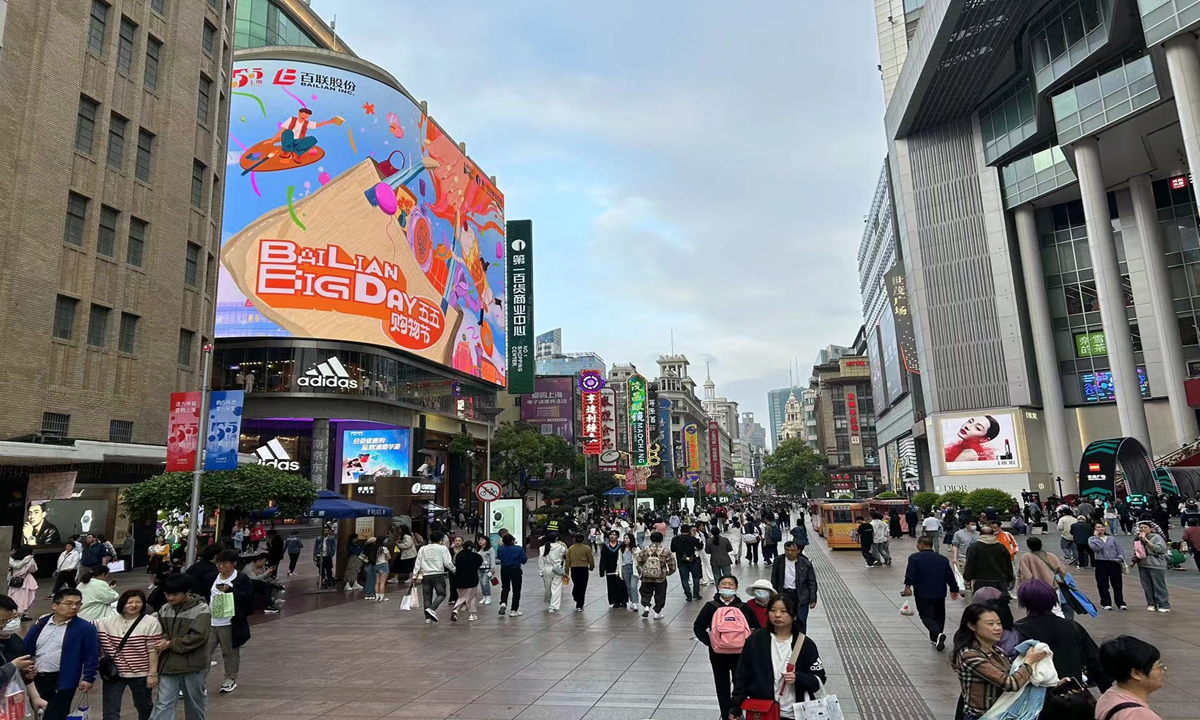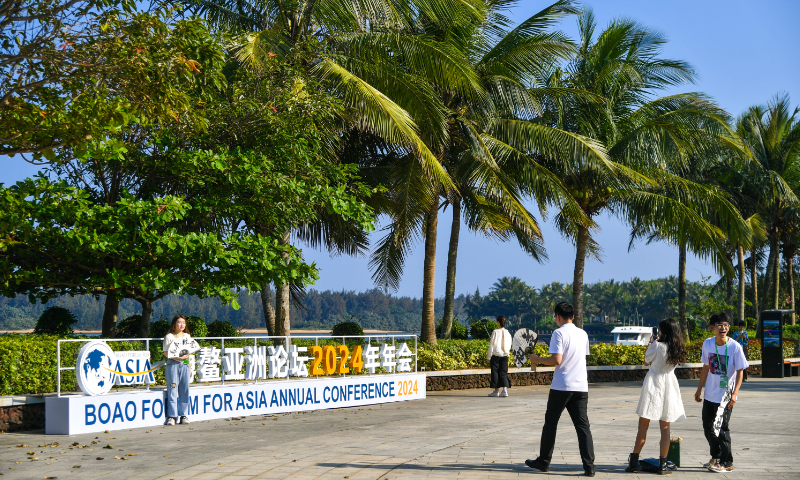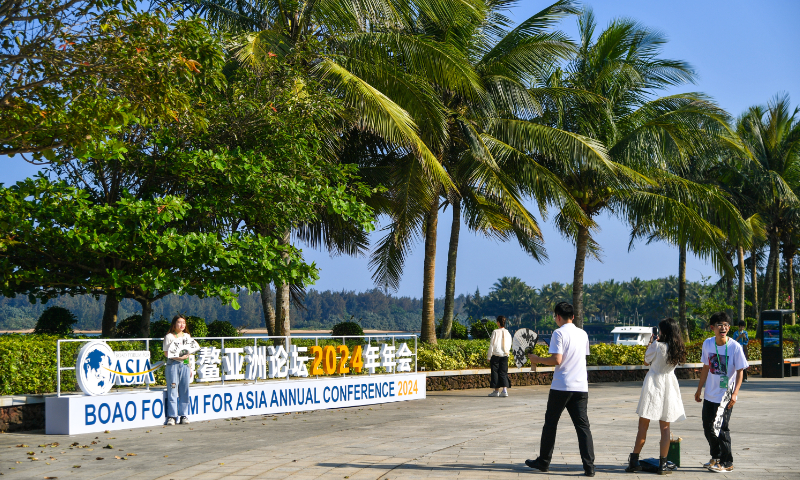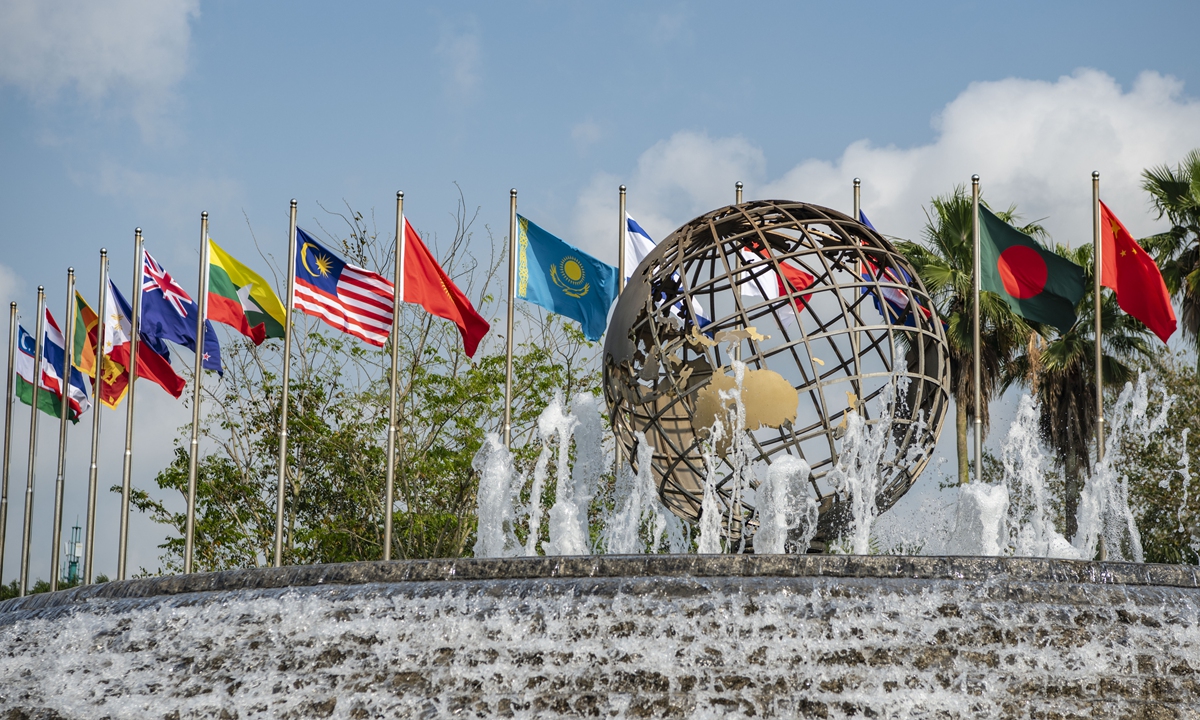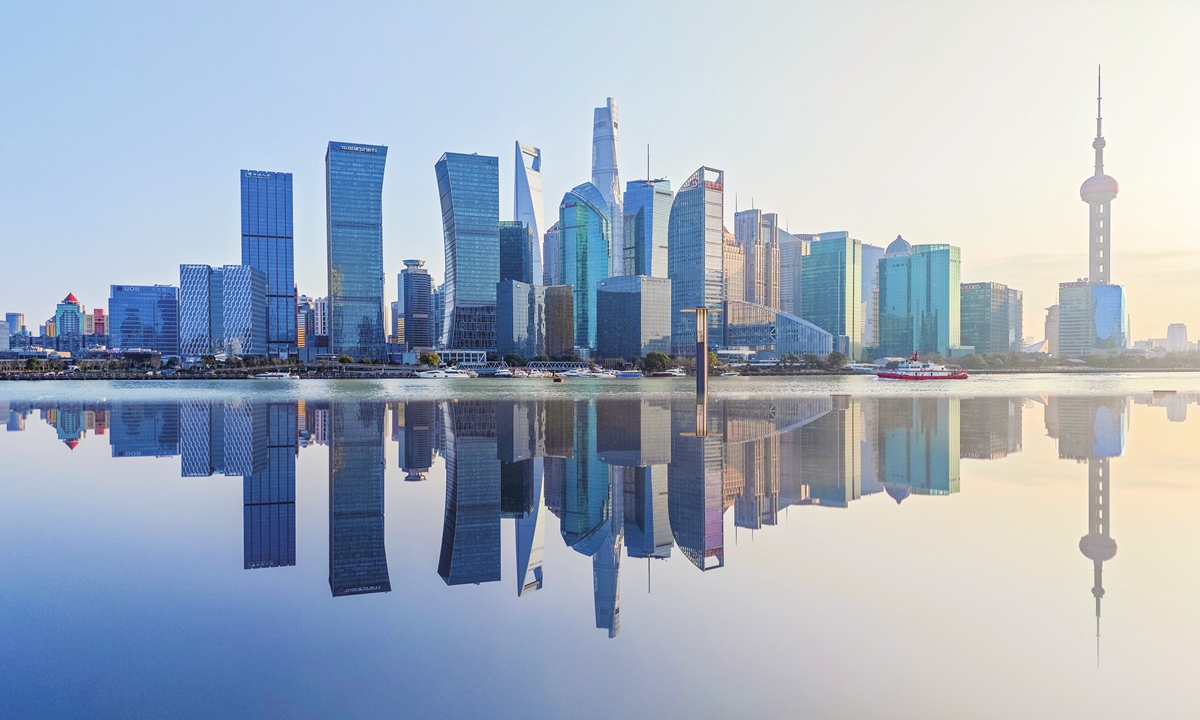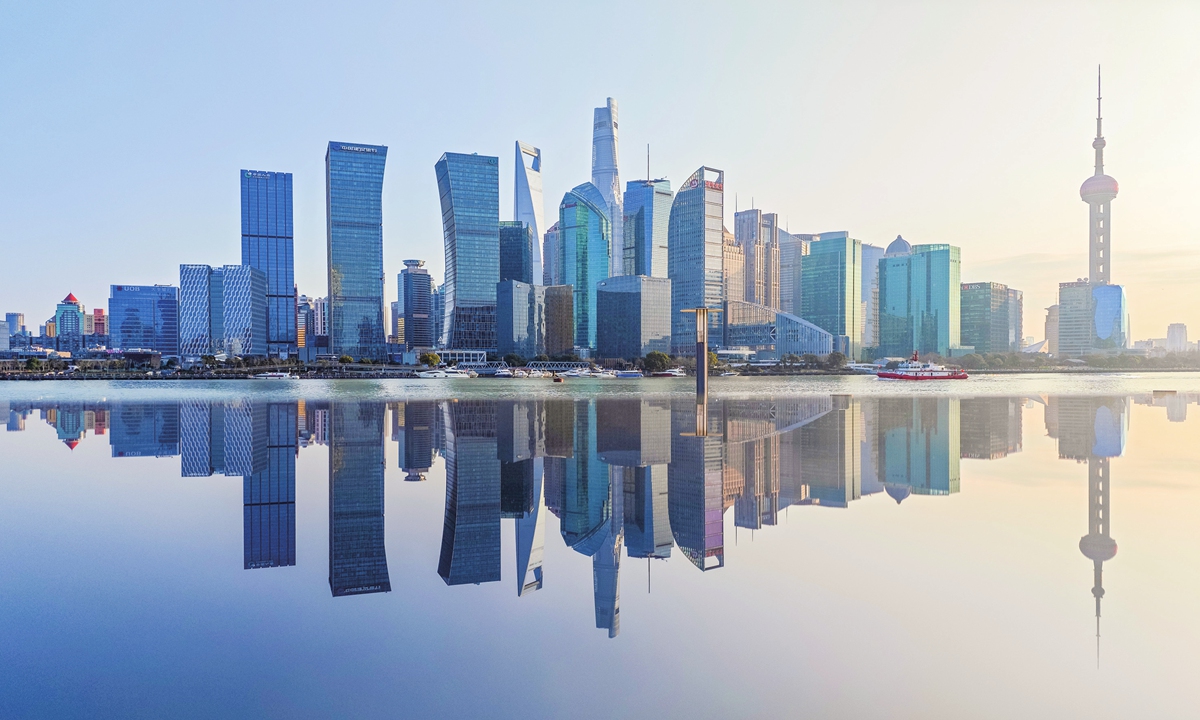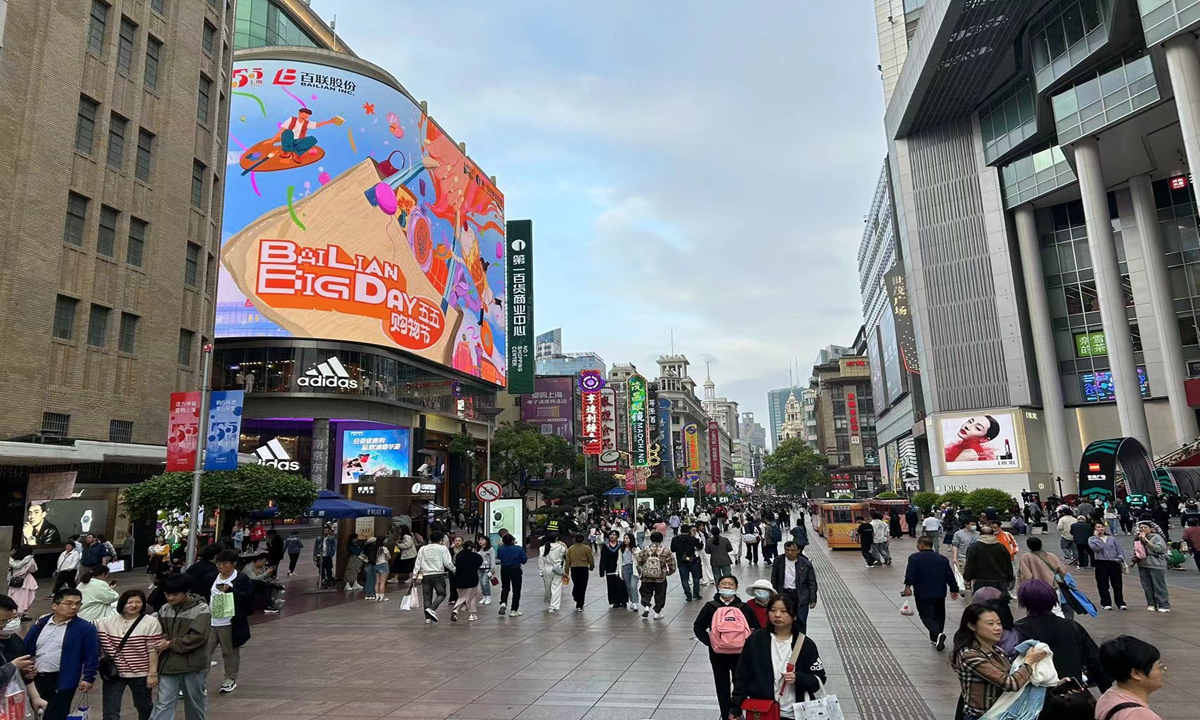
A shopping mall in downtown Shanghai displays the logo of the Shanghai 5.5 Shopping Festival to attract shoppers on April 27, 2024. Photo: Qi Xijia/GT
As the May Day holidays draw near, Chinese cities are buzzing with excitement as trade-in activities and consumption events are set to take center stage across the country, which will help boost the country’s recovery in consumption.
Experts expect that various consumption activities and a tourism boom will drive surge in spending, painting a vivid picture of a vibrant and dynamic market and accelerating China’s economic growth.
As part of a broad plan to boost consumption during the May Day holidays, the Interna-tional Consumption Season 2024 and the fifth Shanghai 5.5 Shopping Festival kicked off in Shanghai on Saturday. Shopping malls in the city are adorned with vibrant deco-rations, displaying notices for price cuts and trade-in offers that promise to entice shop-pers.
Travel agencies are also reporting a surge in orders, indicating strong consumer demand during the holiday season. The vigorous trend highlights the resilience and vigor of China’s consumption market, which has shown strong data for the first three months of 2024.
International Consumption Season 2024 is key event of 2024 Consumption Promotion Year in the second quarter.
During the launch ceremony, Shanghai unveiled new policies to further encourage and optimize sports events, tourism, and exhibitions, improve payment services, and imple-ment measures to support consumer products trade-ins. Various brands, including JD.com, Pinduoduo, Meituan and ele.me, are offering billions of yuan in consumption coupons.
The Ministry of Commerce (MOFCOM) is guiding various regions to organize a varie-ty of consumer promotion activities during the May Day holidays with a global premier festival in Beijing, a sports consumption festival in Shanghai and a food festival in Southwest China’s Yunnan Province, He Yadong, a spokesperson of the MOFCOM, told a press conference on Thursday.
In promoting the trade-in plans, the MOFCOM on Friday announced a new policy to promote auto trade-ins with a subsidy of up to 10,000 yuan ($1,378) for those who replace their old cars with new-energy vehicles as part of an action plan to foster trad-ing-in of consumer goods.
The move comes after 14 Chinese departments, including the MOFCOM, on April 12 jointly released an action plan to promote trade-ins for home appliances and autos in order to accelerate the phasing-out of high-polluting cars and increasing the market share of high-efficiency home appliances.
“These industries are closely related to consumers’ daily lives. The trade-in plans for home appliances and autos is expected to trigger a one-trillion-yuan market,” Zhang Yi, CEO of iiMedia Research Institute, told the Global Times on Saturday.
The strong consumption demand can also be felt in the tourism sector, with railway tickets and travel products selling quickly for the upcoming holidays, indicating a high willingness for travel and a potential surge in consumer spending during the May Day holidays.
A report from Trip.com Group sent to the Global Times showed that the number of tourism trips is expected to increase from the high base set last year, with a significant growth in outbound and inbound travel bookings. As of April 16, outbound flight searches have increased by 56 percent year-on-year, according to the report.
Travel agency Uzai.com has seen a more than 400-percent increase in the number of people purchasing their outbound travel products for the upcoming May Day holidays compared to last year. Data from Fliggy showed that the booking volume for outbound cruises has increased by over 16 times compared to last year, with some products al-ready sold out.
Chinese people’s spending on luxury goods and cultural events are also increasing. Hermes on Thursday reported a 17-percent surge in first-quarter sales, while increasing numbers of Chinese shoppers are splashing out on luxury items in Japan on the weak yen, according to media reports.
Concerts and performances have also been increasing and becoming fully booked since the start of the year. In the first quarter, the number of national performances increased by 72 percent year-on-year, revenue has more than doubled, and viewership is up 77 percent, according to the Economic Daily.
Analysts anticipate that the upcoming May Day holidays will once again drive signifi-cant consumer spending, providing a substantial boost to China’s GDP growth.
“With various government policies and initiatives in place, such as trade-in programs and travel enthusiasm, we expect to set a new record of consumer spending during this holiday period,” Zhang said.
China’s first-quarter retail sales jumped 4.7 percent year-on-year to 12.03 trillion yuan, underscoring stable consumption expansion after a surge in consumer spending during the Spring Festival holidays.
Following a 4.7-percent growth in the first quarter, there is still potential for further con-sumer spending growth, experts said, expecting the development momentum of con-sumption to provide new impetus to propel the world’s second-largest economy.
“Looking ahead to the rest of the year, we anticipate a moderate rebound in consump-tion at around 5 to 6 percent, driven by the gradual improvement in economic condi-tions, rising household incomes, and continued policy support for private enterprises and consumer demand,” Wu Chaoming, a deputy head of the Chasing Research Insti-tute, told the Global Times.
Tian Yun, a veteran economist based in Beijing told the Global Times on Saturday that potential for consumption in China is undeniable and more policies are expected to re-store consumer confidence and create a better consumption environment.
“Once this consumption potential is unleashed, the speed of China’s economic growth will further accelerate,” Tian said.
In the first quarter of this year, consumption remains the main driving force behind eco-nomic growth. China’s GDP grew by 5.3 percent year-on-year, with final consumption expenditure contributing 73.7 percent and driving GDP growth by 3.9 percentage points.
